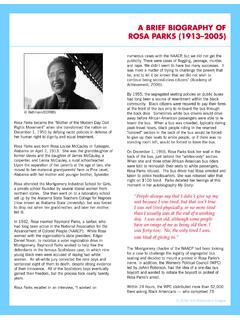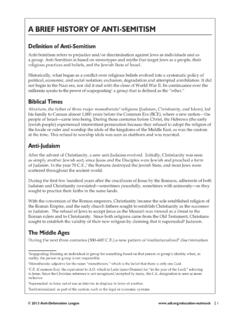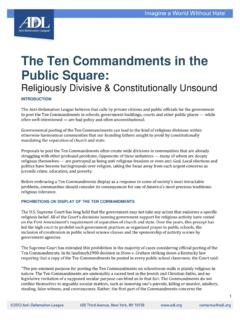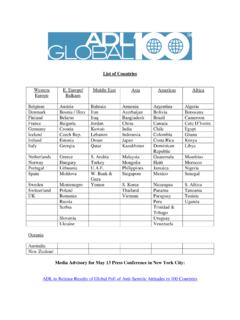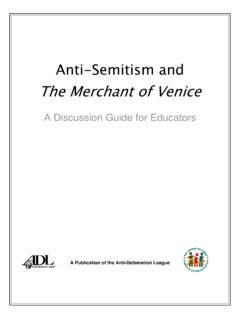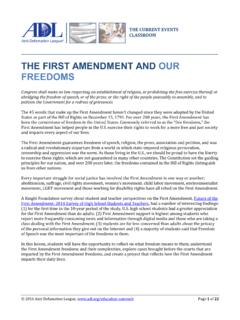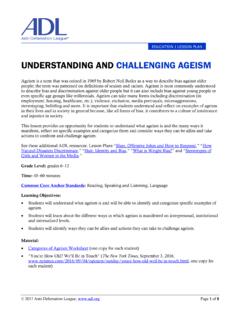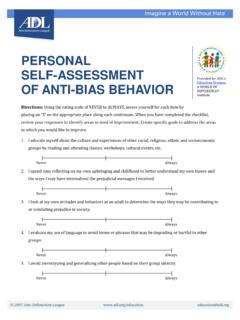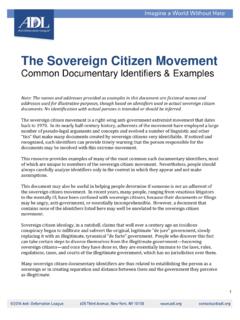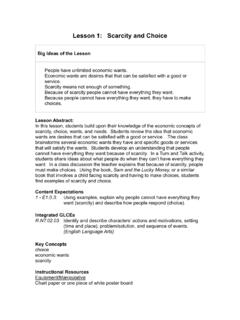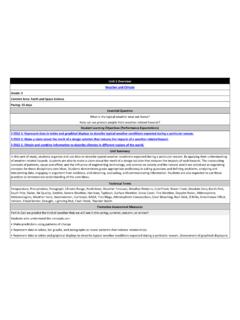Transcription of ABSG Secondary Sample Lesson - Anti-Defamation League
1 2010 Anti-Defamation League Anti-Bias Study Guide ( Secondary Level)Time 45 minutes or 1 class periodGrade Level Grades 9 12 Strategies and Skillscritical thinking skills, small and large group discussion, vocabulary buildingKey Words and Phrases NOTE: This Sample Lesson is from the Anti-Bias Study Guide ( Secondary Level) by the Anti-Defamation League (ADL). To learn more about the Anti-Bias Study Guide and ADL s anti-bias training programs, contact your local ADL Regional Office, write to or call LESSONUnit II, Cultural Identity and Values, Lesson 1: What is Culture?About This Lessonancestorsbiculturalbiracialcommuna lcultureethnicityheritagemulticulturalpr imaryRATIONALEThis Lesson gives students an opportunity to examine the complex concept of culture and to understand that while all people have a culture, for some it may mean the country or region of their ancestors, and for others it may encompass areas including family, religion and community.
2 Students learn that no matter how it is defined, culture gives people a sense of who they are. Before students examine their own cultural backgrounds and United States culture, they will develop a working definition of will examine the complexity of culture. Students will develop a working definition of culture. Lesson pREpARATIONH andouts/Supporting Documents: Who Am I? (one per student)Other Materials: chart paper and markers or chalkboard/whiteboardAdvance Preparation: Reproduce handouts as directed above. Create a chart with the following three columns: Elements of Culture, Cultural Groups and Importance of Culture (see step #1). Anti-Bias Study Guide ( Secondary Level) 2010 Anti-Defamation LeaguepROCEDURESOn a sheet of chart paper or the board, create a chart with the following three columns: 1.
3 Elements of Culture, Cultural Groups and Importance of Culture. Begin the Lesson by having students brainstorm a list of words and phrases that come to mind when they hear the word culture. List these responses in the first column under Elements of Culture. Next ask students to identify the cultural groups that exist in their school community, 2. and write these responses in the second the chart by asking students to brainstorm the importance of culture, and 3. listing their responses in the third :Distribute the 4. Who Am I? handout. Divide students into small groups and assign each group a scenario to discuss from the handout. Reconvene the class and have each group report to the class their responses to the 5.
4 Discussion all the scenarios have been discussed, ask students to look back at the chart created 6. in steps #1-3 above. Give them an opportunity to add ideas to each column based upon what they have : The individuals who contributed to this student handout identify themselves as follows: Cori identifies herself as Asian-American; Kaya identifies herself as biracial; John identifies himself as both deaf and African-American (the descriptor African-American serves two purposes John was born in Africa and is now American and John is Black; James describes himself as Piscataway Indian or as American, depending on the a class discussion about culture using the following questions as starting points:7.)
5 Is it possible for someone to belong to several cultural groups? Give some examples. Do you have to be born into a cultural group to understand the culture? Explain. If someone belongs to several cultural groups, what are some ways that he or she might determine his or her primary culture? What are some instances when a person might feel the need to identify his or her primary culture?How is cultural identity taught to people ( , family celebrations)?Is cultural identity fixed ? If change is possible, what might cause a change?Are there instances when a discussion on culture or cultural heritage might be difficult for a person? Explain ( , being adopted).
6 Elements of CultureCultural GroupsImportance of CulturefoodMexican Americanshared historycustomsSouthernertraditions and celebrationslanguageMuslimsense of belonging 2010 Anti-Defamation League Anti-Bias Study Guide ( Secondary Level)Why is it important for people to have the opportunity to define their own cultural identity as opposed to allowing themselves to be labeled by others as belonging to one group or another?Using the material discussed during this Lesson , have students come together to develop 8. a working definition of culture. Post the definition in the classroom. (The following definition of culture from the Anti-Defamation League can be used as a guide: The pattern of daily life learned by a group of people.)
7 These patterns can be seen in people s language, art, customs, music, food, holiday celebrations and styles of clothing).NOTE: Make sure that the discussion about culture is not limited to race and ethnicity, but includes among other things religion, sexual orientation, age, physical and mental ability, geography, gender and socio-economic status. Have the students discuss the concept that culture can be formed in a number of different ways. Ask the students to consider the idea that sometimes the genesis of a culture is oppression that a group of people has experienced STRATEGIES AND pROCEDURESHave students read one or more of the following titles, and write an essay on the 1.
8 Importance of culture to the events of the story: The Pearl by John Steinbeck, Snow Falling on Cedars by David Guterson, Waiting for Snow in Havana by Carlos Eire, The Bluest Eye by Toni Morrison, Typical American by Gish Gen, Saving Fish From Drowning by Amy Tan or The House on Mango Street by Sandra Cisneros. 2010 Anti-Defamation League Anti-Bias Study Guide ( Secondary Level)Student HandoutWHO Am I?CoriI was born in Korea to a Korean mother and father. I was adopted as an infant by Americans; my adoptive mother s ethnicity is Portuguese, my father s is Welsh. I speak fluent English and Portuguese. I was raised in a diverse community outside Washington, DC, where I have always socialized with students from various backgrounds but my closest friends have always been Hispanic.
9 Culturally, how would you describe Cori? What are some of the ways that Cory might identify herself culturally?Is it possible that at different times in Cori s life she might identify more strongly with one aspect of her cultural identity than another? are some of the obstacles that Cori might face because of her cultural identity? KayaMy father is African-American and my mother is white Irish-American. My mother is Catholic, but my father does not practice any one religion. As a young child growing up in New York, I was raised in a communal environment where there were people of many different races, religions and backgrounds. When I was 7 years old, I moved to a predominantly African-American community.
10 At that point, I had mostly African and Caribbean-American friends. In junior high school, I went to school in a different community where most of the people in my class were white. By high school, I was once again in a diverse , how would you describe Kaya? What are some of the ways that Kaya might identify herself culturally? Is it possible that at different times in Kaya s life she might identify more strongly with one aspect of her cultural identity than another? are some of the obstacles that Kaya might face because of her cultural identity?How are biracial or bicultural people sometimes forced to choose one culture over another? Who forces the choice?
